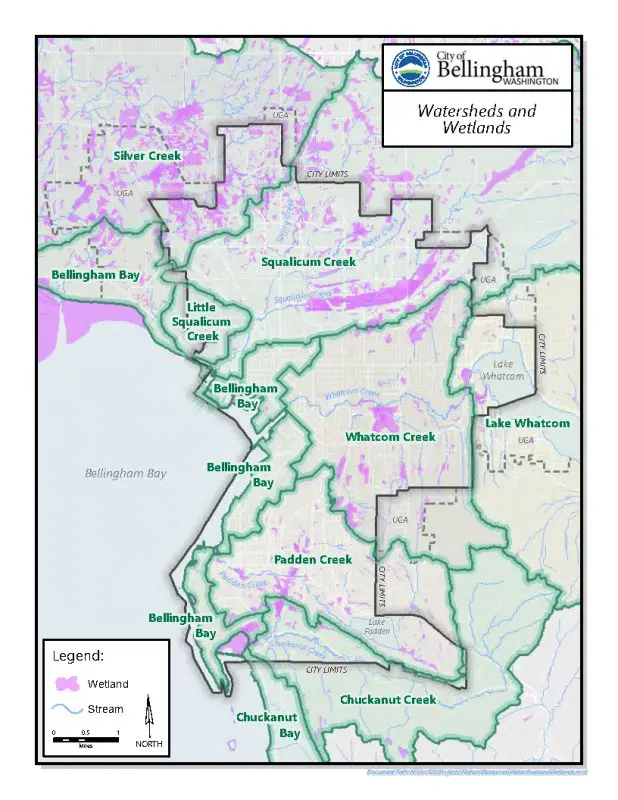The City of Bellingham encompasses eight watersheds and their associated streams (See Figure 1 below). Most of the City’s stream reaches are fish-bearing and support populations of both anadromous and resident salmon and trout. When streams cross roadways and other infrastructure, they often pass through a culvert or other structure.
Fish Passage Barriers
Some structures allow water to pass downstream, but are too narrow, too long, too steep, or installed too high above the water surface for salmon to be able to travel upstream. A single structure can block fish from utilizing miles of stream habitat. These same fish-blocking structures often present maintenance, erosion, and flooding concerns because of their inability to transport flood water, sediment and other suspended debris downstream. Improving these structures is an important way to increase habitat for fish and improve overall stream function.
Prioritizing Fish Passage Improvements
As documented in the City’s Comprehensive Plan, the City is committed to stewarding fish and wildlife habitat, including fish-bearing streams. As part of this commitment, in 2003 the City of Bellingham formally began a fish passage improvement program. The program identifies high priority barrier improvement projects for planning and implementation. This program helps meet the goals and policies of the Bellingham Comprehensive Plan as well as the goals and objectives of the City of Bellingham Comprehensive Stormwater Plan.
In 2003, barriers were assessed and prioritized for improvement using a local decision matrix. The City updated this approach to incorporate additional information and maintain consistency with local, State, and Federal guidance. The City continues to update the City-wide prioritization on a regular basis. In 2022, the City voluntarily entered into a Memorandum of Agreement with the Nooksack Indian Tribe, Lummi Nation, and Washington Department of Fish and Wildlife to formalize their shared goals of improving fish passage. The agreement builds on the City’s substantial work by outlining a framework and next steps to towards inventorying culverts and developing a prioritization strategy and schedule to fix or replace City-owned barriers to fish passage.
- 2022 City of Bellingham Fish Barrier Prioritization
- 2022 Fish Barrier Culvert Remediation Project Memorandum of Agreement
Fish Passage Projects
Resources
- City of Bellingham Restoration Sites Map (star icons show where City-owned fish passage barriers exist)
- City of Bellingham Fish and Wildlife Habitat
- City of Bellingham Habitat Restoration Projects
- City of Bellingham Stormwater Management Program
- City of Bellingham Fish Studies
- WDFW Fish Passage Info
- WDFW Fish Passage Assessment Protocol and Inventory Map
- WRIA 1 Nooksack Basin Salmon Recovery



